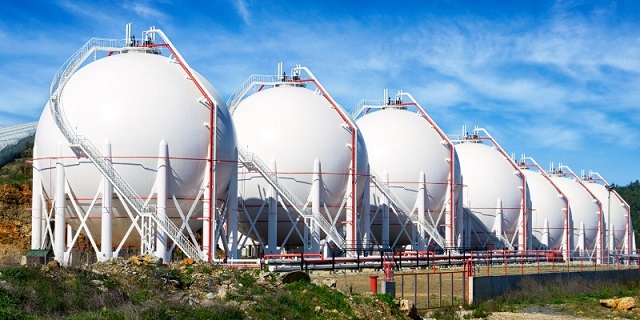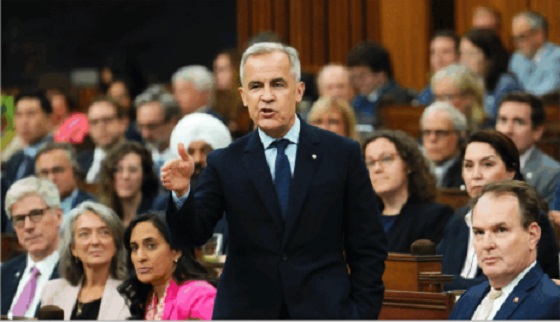Energy
Federal government continues to reject golden opportunities to export LNG

From the Fraser Institute
By Julio Mejía and Elmira Aliakbari
A recent report released by the National Bank of Canada underscores the potential environmental impact of transitioning from coal to natural gas in countries such as India. According to the report, by 2030 the cumulative effect of this transition would result in up to four times fewer greenhouse gases emissions than what Canada emitted in 2021.
Once again, Canada has missed a crucial opportunity to supply clean and reliable energy to an ally. Polish President Andrzej Duda recently expressed interest in purchasing Canadian liquefied natural gas (LNG) from Canada but the Trudeau government did not offer any concrete commitment in response. We’ve seen this movie before.
During his recent visit to Ottawa, Greek Prime Minister Kyriakos Mitsotakis received the same noncommitment. In January 2023, Japanese Prime Minister Fumio Kishida came to Canada hoping to secure a reliable energy source. In response, Trudeau expressed the importance of Canada as a global energy supplier, only to add the disclaimer that the world is “aggressively” moving towards decarbonization. And in 2022, after Putin’s invasion of Ukraine led Germany to seek ways to reduce its reliance on Russian energy sources, German Chancellor Olaf Scholz asked to buy Canadian LNG but the prime minister gave him the cold shoulder. Apparently, Trudeau found no compelling “business case” to export LNG to Europe’s largest economy.
Of course, Canada’s vast natural resources could make a significant positive impact on global energy security, reliability and emissions reduction by reducing reliance on coal while also creating jobs and economic opportunity here at home. Energy supply shortages have already forced European countries to revert to coal-fired power plants—coal contributes more CO2 emissions per unit of energy than natural gas. In the developing world, India aims to double coal production by 2030 to meet the demands of its burgeoning economy and population. Similarly, China quadrupled the amount of new coal power in 2022 and has six times as many plants under construction as the rest of the world combined.
A recent report released by the National Bank of Canada underscores the potential environmental impact of transitioning from coal to natural gas in countries such as India. According to the report, by 2030 the cumulative effect of this transition would result in up to four times fewer greenhouse gases emissions than what Canada emitted in 2021. To put that in perspective, the impact would be even bigger than completely shutting down the Canadian economy.
Moreover, a recent McKinsey report anticipates an annual increase in global LNG demand of 1.5 per cent to 3 per cent by 2035. And according to the latest report by the International Energy Agency (IEA), limited new LNG production means supply will remain tight. The Biden administration recently halted LNG project approvals, increasing the need for Canada to establish its own infrastructure if we’re to seize the opportunity and become a global LNG supplier.
Unfortunately, Canada currently has no operational LNG export terminals, with the first LNG facility expected to commence exporting by 2025. The Trudeau government has frustrated the development of other LNG terminals, primarily through government regulatory barriers including long approval timelines. The government’s emissions caps on the oil and gas sector and federal Bill C-69 (which added more red tape and complexity to the assessment process for major energy projects) have also created uncertainty and deterred—if not outright prohibited—investment in the sector. Additionally, the British Columbia government’s “CleanBC” plan to reduce greenhouse gas emissions has added more regulation. Not surprisingly, a recent survey revealed that investors identify regulatory uncertainty as a major deterrent to investment in Canada’s oil and gas sector.
With the proper polices in place, Canada could provide an energy alternative to our allies and other coal-consuming countries worldwide. The Trudeau government should acknowledge the environmental benefits of our natural gas resources, reform regulations for energy infrastructure projects so they’re more competitive, and allow our energy industry to be a leading source of clean and reliable energy, for the benefit of Canadians and the environment.
Authors:
Energy
Activists using the courts in attempt to hijack energy policy

2016 image provided by Misti Leon, left, sits with her mom, Juliana Leon. Misti Leon is suing several oil and gas companies in one of the first wrongful-death claims in the U.S. seeking to hold the fossil fuel industry accountable for its role in the changing climate.

From the Daily Caller News Foundation
By Jason Isaac
They twist yesterday’s weather into tomorrow’s crisis, peddle apocalyptic forecasts that fizzle, and swap “global warming” for “climate change” whenever the narrative demands. They sound the alarm on a so-called climate emergency — again and again.
Now, the Left has plunged to a new low: weaponizing the courts with a lawsuit in Washington State that marks a brazen, desperate escalation. This isn’t just legal maneuvering—it’s the exploitation of personal tragedy in service of an unpopular anti-energy climate crusade.
Consider the case at the center of a new legal circus: Juliana Leon, 65, tragically died of hyperthermia during a 100-mile drive in a car with broken air conditioning, as a brutal heat wave pushed temperatures to 108 degrees Fahrenheit.
Dear Readers:
As a nonprofit, we are dependent on the generosity of our readers.
Please consider making a small donation of any amount here.
Thank you!
The lawsuit leaps from this heartbreaking event to a sweeping claim: that a single hot day is the direct result of global warming.
The lawsuit preposterously links a very specific hot weather event to theorized global warming. Buckle up—their logic is about to take a wild ride.
Some activist scientists have further speculated that what may be a gradual long-term trend of slight warming thought to be both cyclical and natural, might be possibly exacerbated by the release of greenhouse gases. Some of these releases are the result of volcanic activity while some comes from human activities, including the burning of oil, natural gas and coal.
Grabbing onto that last, unproven thread, the plaintiffs have zeroed in on a handful of energy giants—BP, Chevron, Conoco, Exxon, Phillips 66, Shell, and the Olympic Pipe Company—accusing them of causing Leon’s death. Apparently, these few companies are to blame for the entire planet’s climate, while other oil giants, coal companies, and the billions of consumers who actually use these fuels get a free pass.
Meanwhile, “climate journalists” in the legacy media have ignored key details that will surely surface in court. Leon made her journey in a car with no air conditioning, despite forecasts warning of dangerous heat. She was returning from a doctor’s visit, having just been cleared to eat solid food after recent bariatric surgery.
But let’s be clear: this lawsuit isn’t about truth, justice, or even common sense. It’s lawfare, plain and simple.
Environmental extremists are using the courts to hijack national energy policy, aiming to force through a radical agenda they could never pass in Congress. A courtroom win would mean higher energy prices for everyone, the potential bankruptcy of energy companies, or their takeover by the so-called green industrial complex. For the trial lawyers, these cases are gold mines, with contingency fees that could reach hundreds of millions.
This particular lawsuit was reportedly pitched to Leon’s daughter by the left-leaning Center for Climate Integrity, a group bankrolled by billionaire British national Christopher Hohn through his Children’s Investment Fund Foundation and by the Rockefeller Foundation. It’s yet another meritless claim in the endless list of climate lawsuits that are increasingly being tossed out of courts across the country.
Earlier this year, a Pennsylvania judge threw out a climate nuisance suit against oil producers brought by Bucks County, citing lack of jurisdiction. In New York, Supreme Court Justice Anar Patel dismissed a massive climate lawsuit by New York City, pointing out the city couldn’t claim both public awareness and deception by oil companies in the same breath.
But the Washington State case goes even further, threatening to set a dangerous precedent: if it moves forward, energy companies could face limitless liability for any weather-related injury. Worse, it would give unwarranted credibility to the idea — floated by a leftwing activist before the U.S. Senate — that energy executives could be prosecuted for homicide, a notion that Republican Texas Sen. Ted Cruz rightly called “moonbeam, wacky theory.”
The courts must keep rejecting these absurd lawfare stunts. More importantly, America’s energy policy should be set by Congress—elected and accountable—not by a single judge in a municipal courtroom.
Jason Isaac is the founder and CEO of the American Energy Institute. He previously served four terms in the Texas House of Representatives.
Alberta
Temporary Alberta grid limit unlikely to dampen data centre investment, analyst says
From the Canadian Energy Centre
By Cody Ciona
‘Alberta has never seen this level and volume of load connection requests’
Billions of investment in new data centres is still expected in Alberta despite the province’s electric system operator placing a temporary limit on new large-load grid connections, said Carson Kearl, lead data centre analyst for Enverus Intelligence Research.
Kearl cited NVIDIA CEO Jensen Huang’s estimate from earlier this year that building a one-gigawatt data centre costs between US$60 billion and US$80 billion.
That implies the Alberta Electric System Operator (AESO)’s 1.2 gigawatt temporary limit would still allow for up to C$130 billion of investment.
“It’s got the potential to be extremely impactful to the Alberta power sector and economy,” Kearl said.
Importantly, data centre operators can potentially get around the temporary limit by ‘bringing their own power’ rather than drawing electricity from the existing grid.
In Alberta’s deregulated electricity market – the only one in Canada – large energy consumers like data centres can build the power supply they need by entering project agreements directly with electricity producers.
According to the AESO, there are 30 proposed data centre projects across the province.
The total requested power load for these projects is more than 16 gigawatts, roughly four gigawatts more than Alberta’s demand record in January 2024 during a severe cold snap.
For comparison, Edmonton’s load is around 1.4 gigawatts, the AESO said.
“Alberta has never seen this level and volume of load connection requests,” CEO Aaron Engen said in a statement.
“Because connecting all large loads seeking access would impair grid reliability, we established a limit that preserves system integrity while enabling timely data centre development in Alberta.”
As data centre projects come to the province, so do jobs and other economic benefits.
“You have all of the construction staff associated; electricians, engineers, plumbers, and HVAC people for all the cooling tech that are continuously working on a multi-year time horizon. In the construction phase there’s a lot of spend, and that is just generally good for the ecosystem,” said Kearl.
Investment in local power infrastructure also has long-term job implications for maintenance and upgrades, he said.
“Alberta is a really exciting place when it comes to building data centers,” said Beacon AI CEO Josh Schertzer on a recent ARC Energy Ideas podcast.
“It has really great access to natural gas, it does have some excess grid capacity that can be used in the short term, it’s got a great workforce, and it’s very business-friendly.”
The unaltered reproduction of this content is free of charge with attribution to the Canadian Energy Centre.
-

 Addictions1 day ago
Addictions1 day agoWhy B.C.’s new witnessed dosing guidelines are built to fail
-

 Frontier Centre for Public Policy2 days ago
Frontier Centre for Public Policy2 days agoCanada’s New Border Bill Spies On You, Not The Bad Guys
-

 Business1 day ago
Business1 day agoCarney Liberals quietly award Pfizer, Moderna nearly $400 million for new COVID shot contracts
-

 Energy2 days ago
Energy2 days agoCNN’s Shock Climate Polling Data Reinforces Trump’s Energy Agenda
-

 Opinion1 day ago
Opinion1 day agoCharity Campaigns vs. Charity Donations
-

 Business1 day ago
Business1 day agoMark Carney’s Fiscal Fantasy Will Bankrupt Canada
-

 Opinion1 day ago
Opinion1 day agoPreston Manning: Three Wise Men from the East, Again
-

 COVID-191 day ago
COVID-191 day agoTrump DOJ dismisses charges against doctor who issued fake COVID passports







